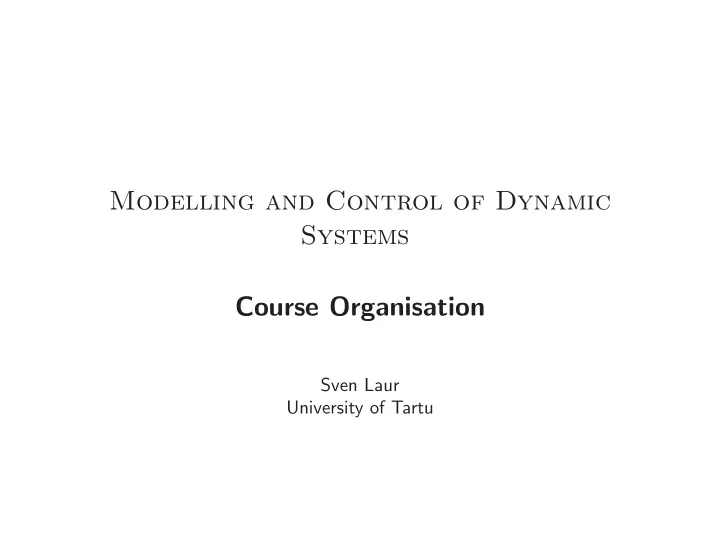

Modelling and Control of Dynamic Systems Course Organisation Sven Laur University of Tartu
Course description The main focus is on the machine-learning methods: ⊲ System identification with neural networks ⊲ Control of dynamic systems using neural networks The course book requires background knowledge: ⊲ The first four lectures covering the basics of linear control theory. ⊲ Maybe there will be another lecture on PID controllers. It will be a practice-oriented course. ⊲ You will spend a lot of time on course project. ⊲ You must be able to apply the course material in practice. 1
System identification True system Statistical approximation u ( t ) y ( t ) u ( t ) x ( t ) u (t- δ ) . . . Neural y ( t ) y (t- δ ) Network y ( t ) = F true ( x ( t ) , u ( t − )) y (t-2 δ ) . . . F true ( · , · ) = ?? Given enough samples over the operating range of a system, it is possible to approximate the true model with a neural network. 2
A closed-loop control system Controller r ( t − δ ) u (t- δ ) y (t) System NN Delay unit A controller uses delayed output signals y ( t − δ ) , . . . , y ( t − kδ ) and delayed input signals u ( t − δ ) , . . . , u ( t − ℓδ ) to compute an appropriate control signal u ( t − δ ) so that y ( t ) would track the reference signal r ( t − δ ) . 3
Administrative details Course language: English ⊲ Slides and reports must be in English. ⊲ Presentations follow the unhappy foreigner rule. Participation: Compulsory ⊲ More than 3 missed seminars gives a grade F . ⊲ Individual arrangements are possible if agreed forehead. Grade = Report + Presentation + Final discussion ⊲ The course report gives a base level grade. ⊲ Discussion can increase or decrease the base grade by one grade point Format: Teamwork with strict deadlines ⊲ Project work is done by teams consisting of two or three persons. ⊲ There will be one strict deadline for the project. 4
Seminar presentations ⊲ Introductory Lecture (22nd Sept) ⊲ Linear Systems (29th Sept) ⊲ Stability of Linear Systems (6th Oct) ⊲ Controllability and Observability of Linear Systems (13th Oct) ⊲ Matlab and R tutorial (??) ⊲ Model Structure Selection (p. 18–37 + paper, 20th Oct) ⊲ Experimental Data and Training (p. 38–84, 27th Oct) ⊲ Validation and Re-evaluation of Inference Steps (p. 85–119, 3rd Nov) ⊲ Hidden Markov Models and Identification of Discrete Systems (??) ⊲ Kalman Filters (??) ⊲ Controllers for Linear Systems (another book, 10th Nov) ⊲ Direct Inverse Control and Internal Model Control (p. 121–142, 17th Nov) ⊲ Feedback Linearisation and Optimal Control (p. 143–175, 24th Nov) ⊲ Predictive Control and Case Studies (p. 178–233, 1st Dec) 5
Course books M. Nørgaard, O. Ravn, N.K. Poulsen, L.K. Hansen Neural Networks for Modelling and Control of Dynamic Systems Chi-Tsong Chen Linear System Theory and Design William L. Brogan Modern Control Theory 6
Course project Identification task can be one of the following: ⊲ Classical data set ⊲ Analysis of Z-log data ⊲ Analysis of chip-on-chip data ⊲ Analysis of gene expression data Control task can be one of the following: ⊲ Control of a previously identified model ⊲ Control of ball on a two-dimensional table ⊲ Control of a particle in an electrical field 7
Course Tools Projects should be completed with Matlab or Gnu R Toolboxes needed in the course are available in Matlab ⊲ The NNSYSID toolbox contains functions for neural network modelling of nonlinear dynamic systems. ⊲ The NNCTRL toolkit provides functions for design and simulation of all the controllers covered in the book. ⊲ Both toolboxes are created by Magnus Nørgaard 8
Recommend
More recommend